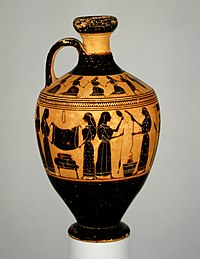Infrastructure tools to support an effective radiation oncology learning health system
Contents
-
(Top)
-
1 Textiles
-
2 Styles of clothing
-
2.1 Staple garments
-
2.2 Other garments
-
2.2.1 Allix
-
2.2.2 Ampechone
-
2.2.3 Aphabroma
-
2.2.4 Βirrus
-
2.2.5 Chitoniskos
-
2.2.6 Chiridota
-
2.2.7 Chlaina, Ephaptis
-
2.2.8 Chlanis
-
2.2.9 Cyclas
-
2.2.10 Dalmatica
-
2.2.11 Diphthera
-
2.2.12 Exomis
-
2.2.13 Encomboma
-
2.2.14 Egkuklon and Tougkuklon
-
2.2.15 Kandys
-
2.2.16 Katonake
-
2.2.17 Kolobus
-
2.2.18 Krokotos
-
2.2.19 Ledos, Ledarion, Speiron, Speirion
-
2.2.20 Pharos
-
2.2.21 Phoinikis
-
2.2.22 Sisura
-
2.2.23 Spolas
-
2.2.24 Tebennos
-
2.2.25 Tribon
-
2.2.26 Paenula/Phainoles
-
2.2.27 Xystis, Ephestris
-
2.2.28 Named after colors and texture
-
-
2.3 Eastern clothing
-
2.4 Undergarments
-
2.5 Nudity
-
-
3 Accessories
-
4 See also
-
5 References
-
6 External links
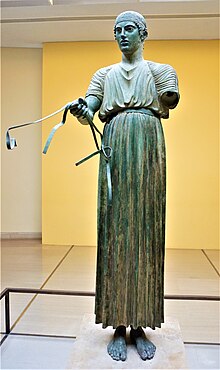
Clothing in ancient Greece refers to clothing starting from the Aegean bronze age (3000 BCE) to the Hellenistic period (31 BCE).[1] Clothing in ancient Greece included a wide variety of styles but primarily consisted of the chiton, peplos, himation, and chlamys.[2] Ancient Greek civilians typically wore two pieces of clothing draped about the body: an undergarment (χιτών : chitōn or πέπλος : péplos) and a cloak (ἱμάτιον : himátion or χλαμύς : chlamýs).[3] The people of ancient Greece had many factors (political, economic, social, and cultural) that determined what they wore and when they wore it.[2]
Clothes were quite simple, draped, loose-fitting and free-flowing.[4] Customarily, clothing was homemade and cut to various lengths of rectangular linen or wool fabric with minimal cutting or sewing, and secured with ornamental clasps or pins, and a belt, or girdle (ζώνη: zōnē).[4][page needed] Pieces were generally interchangeable between men and women.[5] However, women usually wore their robes to their ankles while men generally wore theirs to their knees depending on the occasion and circumstance.[4] Additionally, clothing often served many purposes than just being used as clothes such as bedding or a shroud.[6]
In ancient Greece the terms ἀκεστής (male) and ἀκέστρια (female) were used for people who patched and restored clothing.[7]
The shoemakers had two kind of knives for cutting leather, the σμίλη or σμιλίον, which has a straight blade and the τομεὺς or περιτομεύς, which had a crescent shaped blade.[8]
Textiles
Small fragments of textiles have been found from this period at archeological sites across Greece.[9][page needed] These found textiles, along with literary descriptions, artistic depictions, modern ethnography, and experimental archaeology, have led to a greater understanding of ancient Greek textiles.[4][page needed] Clothes in ancient Greece were mainly homemade or locally made.[1][page needed] All ancient Greek clothing was made out of natural fibers. Linen was the most common fabric due to the hot climate which lasted most of the year.[4][page needed] On the rare occasion of colder weather, ancient Greeks wore wool.[4][page needed] Silk was also used for the production of clothing though for ceremonial purposes by the wealthy.[4][page needed] In Aristotle's The History of Animals, Aristotle talks about the collection of caterpillar cocoons to be used to create silk.[10][page needed]
Production process
In the production of textiles, upright warp-weighted loom were used to weave clothing in Ancient Greece.[11][page needed]
These looms had vertical threads or warps that were held down by loom weights.[11][page needed] The use of looms can be seen in Homer's Odyssey when Hermes comes across Calypso weaving on a loom.[12] Another example of the loom in Homer's Odyssey can be seen when Odysseus comes across Circe for the first time.[13] The use of looms can also be seen being depicted on ancient Greek pottery.[4][page needed]
Color and decoration
Clothing in ancient Greece has been found to be quite colorful with a wide variety of hues.[4][page needed][14] Colors found to be used include black, red, yellow, blue, green, and purple.[4][page needed] Yellow dyed clothing has been found to be associated with a woman's life cycle.[4][page needed] The elite typically wore purple as a sign of wealth and money as it was the most expensive dye due to the difficulty in acquiring it.[4][page needed] The ancient Greeks also embroidered designs into their clothes as a form of decoration.[9][page needed] The designs embroidered included representations of florals patterns and geometric patterns as well intricate scenes from Greek stories.[9][page needed] An example of this embroidery can be seen in Homer's Iliad where Helen is described as wearing a purple textile where she embroidered a scene of Trojans in battle.[15]
There was the proverbial phrase Θετταλικαὶ πτέρυγες, meaning Thessalian wings, because the Thessalian cloaks had a small flap in each side which resemble wings.[16]
Styles of clothing
The epiblema (ἐπίβλημα), periblema (περίβλημα), amfelone (ἀμφελόνη) were general terms for the outer clothing[17][18][19][20] while the endyma (ἔνδυμα) was most often applied to the underclothing.[21] The lope (λώπη) and lopos (λῶπος) were also general terms referring to the mantle.[22]
Staple garments
Chiton
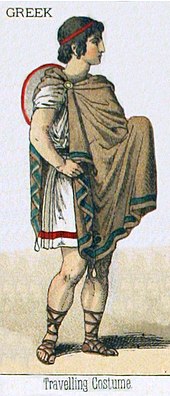
The chiton (plural: chitones) was a garment of light linen consisting of sleeves and long hemline.[2][6] It consisted of a wide, rectangular tube of material secured along the shoulders and lower arms by a series of fasteners.[23][page needed] The chiton was commonly worn by both men and women but the time period in which each did so depended.[1] Chitons typically fell to the ankles of the wearer, but shorter chitons were sometimes worn during vigorous activities by athletes, warriors, or slaves.[9][page needed]
Often excess fabric would be pulled over a girdle, or belt, which was fastened around the waist (see kolpos).[3] To deal with the bulk sometimes a strap, or anamaschalister was worn around the neck, brought under the armpits, crossed in the back, and tied in the front.[3] A himation, or cloak, could be worn over top of the chiton.[2]
Chlamys
The chlamys was a seamless rectangle of woolen material worn by men for military or hunting purposes.[3] It was worn as a cloak and fastened at the right shoulder with a brooch or button.[4]
The chlamys was typical Greek military attire from the 5th to the 3rd century BC.[24] It is thought that the chlamys could ward against light attacks in war.[2]
The chlamys went on to become popular in the Byzantine Empire by the high class and wealthy.[1]

Himation
The himation was a simple wool outer garment worn over the peplos or chiton by both men and women.[2][6] It consisted of heavy rectangular material, passing under the left arm and secured at the right shoulder.[9] The himation could also be worn over both shoulders.[4] Women can be seen wearing the himation over their head in depictions of marriages and funerals in art.[4] Men and boys can also be seen depicted in art as wearing solely the himation with no other clothing.[1] A more voluminous himation was worn in cold weather.[3] The himation is referenced as being worn by Socrates in Plato's Republic.[25]
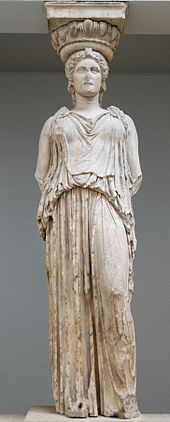
Peplos
The peplos was a rectangular piece of woolen garment that was pinned at both shoulders leaving the cloth open down one side which fell down around the body.[2][6] The top third of the cloth was folded over to create an over-fold.[4][page needed] A girdle or belt was used to fasten the folds at the waist and could be worn over or under the over-fold.[4][page needed] The overfold was called apoptygma (ἀπόπτυγμα).[26] Variations of the peplos were worn by women in many periods such as the archaic, early classical, and classical periods of ancient Greece.[1]
Other garments
Allix
Allix (Ἄλλικα) and Gallix (Γάλλικά) was a chlamys, according to Thessalians, which was fastened with gilt brooches.[27]
Ampechone
Ampechone (ἀμπεχόνη, ἀμπέχονον, ἀμπεχόνιον), was a shawl or scarf worn by women over the chiton or inner garment.[28][29][30]
Aphabroma
Aphabroma (ἀφἀβρωμα), was a garment worn by Megarian women. According to legend, when Abrota died, her husband Nisos commanded all the Megarian women to wear a garment similar to the one Abrota had worn, which was called aphabroma. It was still in use in the time of Plutarch.[31]
Βirrus
Βirrus or Βurrus (βίρρος), was a cloak or cape furnished with a hood; a heavy, coarse garment for use in bad weather.[32]
Chitoniskos
Chitoniskos (χιτωνίσκος), was a short chiton[33] sometimes worn over another chiton.[34]
Chiridota
Chiridota (singular χειριδωτός, plural χειριδωτοί), were tunics with sleeves.[35][36][37]
Chlaina, Ephaptis
Chlaina (Χλαῖνα) or Chlaine (Χλαῖνη), was a thick overgarment/coat. It was laid over the shoulders unfolded (ἁπλοΐς; haploís) or double-folded (δίπλαξ; díplax) with a pin. It was used as a winter cloak or as a blanket, but was finer than the sisura which was also used for a similar purpose.[22]
Ephaptis (ἐφαπτίς) was a more costly form of the chlaina and was used by hunters and warriors.[22]
Chlanis
Chlanis (Χλανὶς), was a finer garment than chlaina and it was worn in hot weather by men, at other times by ladies, old men and effeminate persons.[22]
Cyclas
Cyclas (Κυκλάς), was a luxurious robe worn by Roman women. In the fifth century was used as a ceremony dress and was used also by men.[38]
Dalmatica
Dalmatica (Δαλματική) or Delmatica (Δελματική), a tunic with long sleeves, introduced from Dalmatia.[39]
Diphthera
Diphthera (Διφθέρα) (meaning leather), a shepherd's wrap made of hides.[40]
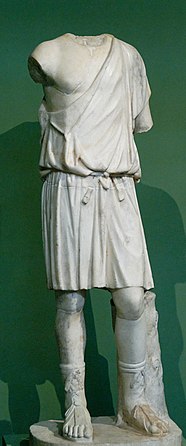
Exomis
The exomis was a tunic which left the right arm and shoulder bare. It was worn by slaves and the working classes.[41][42] In addition, it was worn by some units of light infantry.
Encomboma
The encomboma (ἐγκόμβωμα) was an upper garment tied round the body in a knot (κόμβος), whence the name, and worn to keep the tunic clean.[43][44]
Egkuklon and Tougkuklon
Egkuklon (Ἔγκυκλον) and Tougkuklon (Τοὔγκυκλον) were woman's upper garment.[45]
Kandys
Kandys (κάνδυς) was a Persian mantle with sleeves worn by Greek women.[46]
Katonake
Katonake (Κατωνάκη), it was a cloak which had a fleece (nakos) hanging from the lower (kato) parts, that is a wrapped-around hide and stretched down to the knees.[47]
Kolobus
Kolobus or Kolobium (Κολόβιον) was like a Tunic but sleeveless.[48][49]
Krokotos
Krokotos (Κροκωτός) was a saffron-coloured robe/chiton.
Ledos, Ledarion, Speiron, Speirion
Λῇδος, Λῃδάριον, Σπεῖρον, Σπειρίον were summer garments.[50]
Pharos
Pharos (Φᾶρος) was used in Homer in a general sense, referring to a textile fabric for women's garments, swaddling clothes, winding sheets, and as a substitute for sails and in a more special sense for a man's garment.
As a garment it was worn by the people of rank. Most probably it was larger than the chlaina.[22]
Phoinikis
Phoinikis (Φοινικὶς) was a military chlamys.[51]
Sisura
Sisura (Σισύρα or Σίσυρα) or Sisurna (Σίσυρνα),[52] type of inexpensive cloak/mantle, like a one-shoulder tunic.[53]
Spolas
Spolas (Σπολάς), a leather cloak, perhaps being worn on top.[54]
Tebennos
Tebennos (Τήβεννος) and Tebenneion (Tηβέννειον), a garment like Toga.[55]
Tribon
Tribon (Τρίβων), simple cloak. It was worn by Spartan men and was the favorite garment of the Cynic philosophers.[56][57][58][59]
Paenula/Phainoles
Paenula, Greeks called it Phainoles (φαινόλης), was a thick upper garment without sleeves, buttoned or stitched up in front, with a hood generally fastened on to it.[60]
Xystis, Ephestris
Xystis (ξυστὶς) was a garment of fine quality worn by women of quality at festivals and by great men especially on state occasions and was used on the stage for the attire of heroic personages.[22]
Ephestris (ἐφεστρὶς) was somewhat similar to the xystis. In Xenophon called it παχεῖα (thick) which most probably mean that it was not so light as the xystris.[22]
Named after colors and texture
Some mantles denote colour and texture, for example the krokotos (κροκωτὸς), meaning saffron-coloured, was an over-garment worn by women and the vatrachis (βατραχίς), meaning frogcoloured, was a man's garment.[22]
Eastern clothing
The Greeks adopted clothing from the East such as the Lydian μανδύη, the καπυρὶς ἀκταῖα or σαραπὶς of Persia and nationalised them all over the Greek world.[22]
Undergarments

Women often wore a strophic, the bra of the time, under their garments and around the mid-portion of their body.[4] The strophic was a wide band of wool or linen wrapped across the breasts and tied between the shoulder blades.[3]
Men and women sometimes wore triangular loincloths, called perizoma, as underwear.[3]
Nudity
The ancient Greeks viewed nudity as an essential part of their identity that set them apart from other cultures.[61] Males went nude for athletic events such as the Olympics.[61] Male nudity could also be seen in Symposiums, a social event for elite men.[62] Male nudity could also be seen in rituals such as a boys coming of age ceremony.[62] Public female nudity was generally not accepted in ancient Greece,[61] though occasionally woman are nude in athletic events and religious rituals.[61] Women who were prostitutes are commonly depicted as nude in ancient Greek art.[4] Partial nudity could also be seen through the linen fabric being expertly draped around the body, and the cloth could be slightly transparent.[9]
Accessories
Fasteners, belts, sashes, buttons, pins, etc.
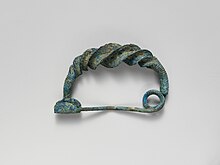
Since clothing was rarely cut or sewn, fasteners and buttons were often used to keep garments in place.[4][9] Small buttons, pins, and brooches were used.[4][9]
Porpe (πόρπη), was the pin of a buckle or clasp and also the clasp itself.[63] Large straight pins, called peronai, were worn at the shoulders, facing down, to hold the chiton or peplos in place.[3] Fibulae were also used to pin the chiton, peplos or chlamys together.[4][page needed] These fibulae were an early version of the safety pin.[4] In Sophocles' Oedipus Rex, Oedipus uses pins to stab his eyes out after learning he was the one to kill his father and marry his mother.[64][page needed]
Belts, sashes, or girdles were also worn at the waist to hold chitons and peplos.[2][4][page needed]
Zone (ζώνη) was a flat and rather broad girdle worn by young unmarried women (ζώνη παρθενική) around their hips. In addition, it was a broad belt worn by men round their loins, and made double or hollow like our shot-belts, for carrying money. Furthermore, it was also called a soldier's belt, worn round the loins, to cover the juncture of the cuirass and the kilt of leather straps.[65]
Sudarium (σουδάριον), also called ἡμιτύβιον and καψιδρώτιον, was a linen handkerchief used mostly to remove sweat from the brow or face. It was sometimes worn around the neck and, later periods, waved in the circus to indicate acclaim.[66]
Footwear

Hesiod in his Works and Days advise his brother Perses to cover his feet with πίλοις inside his boots, similar to modern socks.[67]
Men and women wore footwear such as sandals, shoes or boots, which were made most commonly out of leather.[4][page needed][9][page needed] At home, people typically went barefoot.[24] It was also common for philosophers such as Socrates to be barefoot as well.[9][page needed]
The Athenian general, Iphicrates, made soldiers' boots that were easy to untie and light. These boots were called afterwards, from his name, Iphicratids (Greek: Ἰφικρατίδες).[68][69]
The bodyguards of the Peisistratid tyrants were called wolf-feet (Λυκόποδες). According to one theory, they were called like this because they had their feet covered with wolf-skins, to prevent frostbites.[70]
Kassyma (κάσσυμα) was an extra thick sole for the shoe or sandal frequently used to increase the height of the wearer. They were made of cork.[71]
Cothurnus (Κόθορνος) was a high shoe or buskin with several soles. It covered the whole foot, and rose as high as the middle of the leg. It was made so as to fit either foot and was generally fastened in front with straps.[72]
Other Footwear
Arbele (ἀρβύλη, arbýlē), a short or half-boot.[73]
Baucides (βαυκίδες, baukídes) or Boucidium (βουκίδιον, boukídion), a kind of costly shoe of a saffron colour, worn exclusively by women.[74]
Carbatina (καρβατίνη, karbatínē), shoes worn by rustics, with sole and upper leather all in one. A piece of untanned ox-hide placed under the foot and tied up by several thongs, so as to cover the whole foot and part of the leg.[75]
Crepida (κρηπίς, krēpís), a kind of shoe between a closed boot and plain sandals.[76]
Croupezai (κρούπεζαι, kroúpezai), croupezia (κρουπέζια, kroupézia), or croupala (κρούπαλα, kroúpala), wooden shoes worn by peasants and took their names from noise which they made. Photius wrote that they were used for treading out olives.[77]
Embas (ἐμβάς, embás) or embates (ἐμβάτης, embátēs), kind of a closed boot.[78]
Endromis (ἐνδρομίς, endromís), a kind of a leather boot (In Roman times endromis was a thick woollen rug/cloak).[79][80]
Headgear

Women and men wore different types of headgear.[2] Women could wear veils to preserve their modesty.[9][page needed] Men would wear hats for protection against the elements.[4][page needed] Both men and women also wore different types of headbands to pull their hair up or for decoration.[9][page needed]
Pileus and petasos were common hats for men in ancient Greece.[4][page needed] The pileus was a close-fitting cap which could have been made out of a variety of materials such as leather and wool.[4][page needed] While the petasos was a broad brimmed hat with an attached cord that hung down around the chin.[4][page needed]
Kredemnon (κρήδεμνον) was a woman's headdress or veil of uncertain form, a sort of covering for the head with lappets hanging down to the shoulders on both sides, and when drawn together concealing the face.[81][82][83]
Ampyx (ἄμπυχ) was a headband worn by Greek women to confine the hair, passing round the front of the head and fastening behind. It appears generally to have consisted of a plate of gold or silver, often richly worked and adorned with precious stones.[84]
Sphendone (σφενδόνη) was a fastening for the hair used by the Greek women.[85]
Tainia was a headband, ribbon, or fillet.
Kekryphalos (κεκρύφαλος) was a Hairnet[86] and Sakkos (σάκκος) a hair sack/cap used by the Greek women.[86]
Diadema (διάδημα), a fillet which was the emblem of sovereignty.[87]
Jewelry
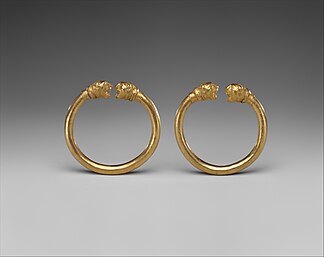
Ornamentation in the form of jewelry, elaborate hairstyles, and make-up was common for women.[9] While jewelry was used to decorates oneself, it was also used as status symbol to show one's wealth.[4] The Greeks wore jewelry such as rings, wreaths, diadems, bracelets, armbands, pins, pendants, necklaces, and earrings.[88] Small gold ornaments would be sewn onto their clothing and would glitter as they moved.[3] Common designs on jewelry in ancient Greece included plants, animals and figures from Greek mythology.[4] Gold and silver were the most common mediums for jewelry.[89] However, jewelry from this time could also have pearls, gems, and semiprecious stones used as decoration.[4] Jewelry was commonly passed down in families from generation to generation.[88]
Greeks used many different words to describe the earrings including the Elikteres (ἑλικτῆρες), Enotia (ἑνώτια, sometimes called Enodia (ἑνώδια) in some inscritpions), Plastra (πλάστρα) and Ellobia (ἑλλόβια).[90]
Sphingter (σφιγκτήρ) was a coil bracelet, made of gold, worn by women on the left arm.[91] Pselion (ψέλιον) was a kind of bracelet or armlet worn by Persians, but also adopted by Greeks.[92] The bracelets who were worn on the wrist were called περικάρπια, while these that were worn on the upper arm were called περιβραχιόνια. The bracelet that went several times round the arm were called δράκοντες (dragons) or ὄφεις (snakes) due to their resemblance to serpents.[92]
Periscelis (περισκελίς), was an anklet worn by women. The plebeian women wore anklets of silver, whereas the patricians of gold.[93][94] These ornaments are also called περισφύρια, while sometimes they are referred to by more general names such as πέδαι (singular πέδη) or ἀμφιδέαι (singular ἀμφιδέα).[95] The word πέδη was also used to describe a fetter or shackle for the ankles constructed as to deprive the prisoner almost wholly of the power of walking.[96][94]
See also
References
- ^ a b c d e f Condra, Jill (2008). The Greenwood Encyclopedia of Clothing Through World History, Vol. 1. Greenwood Press. ISBN 978-0-313-33662-1.
- ^ a b c d e f g h i Nigro, Jeff (1 February 2022). "Ancient Greek Dress: The Classic Look". Art Institute of Chicago.
- ^ a b c d e f g h i Alden, Maureen (January 2003), "Ancient Greek Dress", Costume, 37 (1): 1–16, doi:10.1179/cos.2003.37.1.1
- ^ a b c d e f g h i j k l m n o p q r s t u v w x y z aa ab ac ad ae af Lee, Mireille M. (2015). Body, dress, and identity in ancient Greece. New York: Cambridge University Press. ISBN 978-1-107-05536-0.
- ^ Adkins, Lesley, and Roy Adkins. Handbook to Life in Ancient Greece. New York: Facts On File, 1997. Print.
- ^ a b c d "Ancient Greek Dress". The Metropolitan Museum of Art. Retrieved 20 May 2023.
- ^ Harry Thurston Peck, Harpers Dictionary of Classical Antiquities (1898), Sartor
- ^ A Dictionary of Greek and Roman Antiquities (1890), Scalprum
- ^ a b c d e f g h i j k l m Johnson, Marie, Ethel B. Abrahams, and Maria M. L. Evans. Ancient Greek Dress. Chicago: Argonaut, 1964. Print.
- ^ Aristotle. (1902). History of animals in ten books. London: G. Bell. doi:10.5962/bhl.title.19197.
- ^ a b Broudy, Eric (1993). The book of looms: a history of the handloom from ancient times to the present. Hanover: Brown University Press. ISBN 978-0-87451-649-4.
- ^ Homer (15 November 2018), Pulleyn, Simon (ed.), "Odyssey", Homer: Odyssey, Book 5, Oxford University Press, doi:10.1093/oseo/instance.00280463, ISBN 978-0-19-878880-5, retrieved 4 June 2023
- ^ Homer (15 November 2018), Pulleyn, Simon (ed.), "Odyssey", Homer: Odyssey, Book 10, Oxford University Press, doi:10.1093/oseo/instance.00280463, ISBN 978-0-19-878880-5, retrieved 4 June 2023
- ^ Blanck, Horst (1976). Einführung in das Privatleben der Griechen und Römer. Internet Archive. Darmstadt : Wissenschaftliche Buchgesellschaft [Abt. Verl.] p. 45. ISBN 978-3-534-06066-5.
- ^ Homer (29 June 1995), Griffin, Jasper (ed.), "Iliad", Homer: Iliad Book Three, Oxford University Press, doi:10.1093/oseo/instance.00280592, ISBN 978-0-19-814130-3, retrieved 5 June 2023
- ^ Suda, theta, 290
- ^ "Harry Thurston Peck, Harpers Dictionary of Classical Antiquities (1898), Epiblēma". www.perseus.tufts.edu. Retrieved 15 January 2024.
- ^ "Harry Thurston Peck, Harpers Dictionary of Classical Antiquities (1898), Amictus". www.perseus.tufts.edu. Retrieved 15 January 2024.
- ^ "Perseus Encyclopedia, epiblema". www.perseus.tufts.edu. Retrieved 15 January 2024.
- ^ "Henry George Liddell, Robert Scott, A Greek-English Lexicon, ἀμφελόνη". www.perseus.tufts.edu. Retrieved 15 January 2024.
- ^ "Harry Thurston Peck, Harpers Dictionary of Classical Antiquities (1898), Indūtus". www.perseus.tufts.edu. Retrieved 15 January 2024.
- ^ a b c d e f g h i A Dictionary of Greek and Roman Antiquities (1890), Pallium
- ^ Garland, Robert. Daily Life of the Ancient Greeks. Westport, Conn: Greenwood Press, 2009. Print.
- ^ a b Art, Authors: Department of Greek and Roman. "Ancient Greek Dress | Essay | The Metropolitan Museum of Art | Heilbrunn Timeline of Art History". The Met's Heilbrunn Timeline of Art History. Retrieved 15 January 2024.
- ^ Plato (14 September 2007). The Republic. Penguin Classics. ISBN 978-0-14-045511-3.
- ^ Perseus Encyclopedia, Apoptygma
- ^ Suda, alpha, 1224
- ^ A Dictionary of Greek and Roman Antiquities (1890)William Smith, LLD, William Wayte, G. E. Marindin, Ed., Ampechone
- ^ Henry George Liddell, Robert Scott, An Intermediate Greek-English Lexicon, Ampechone
- ^ Harry Thurston Peck, Harpers Dictionary of Classical Antiquities (1898), Ampechone
- ^ A Dictionary of Greek and Roman biography and mythology, Abrota
- ^ A Dictionary of Greek and Roman Antiquities (1890), Birrus
- ^ Henry George Liddell, Robert Scott, An Intermediate Greek-English Lexicon, Chitoniskos
- ^ Perseus Encyclopedia, Chitoniskos
- ^ John Conington, Commentary on Vergil's Aeneid, Volume 2, 9.616
- ^ A Dictionary of Greek and Roman Antiquities (1890), Manica
- ^ Henry George Liddell, Robert Scott, An Intermediate Greek-English Lexicon, Chiridotos
- ^ A Dictionary of Greek and Roman Antiquities (1890), Cyclas
- ^ A Dictionary of Greek and Roman Antiquities (1890), Dalmatica
- ^ Suda, delta, 1290
- ^ A Dictionary of Greek and Roman Antiquities (1890), William Smith, LLD, William Wayte, G. E. Marindin, Ed., Comoedia
- ^ Harry Thurston Peck, Harpers Dictionary of Classical Antiquities (1898), Exōmis
- ^ A Dictionary of Greek and Roman Antiquities (1890), William Smith, LLD, William Wayte, G. E. Marindin, Ed., Encomboma
- ^ Harry Thurston Peck, Harpers Dictionary of Classical Antiquities (1898), Encombōma
- ^ Suda, tau, 812
- ^ "L. D. Caskey, J. D. Beazley, Attic Vase Paintings in the Museum of Fine Arts, Boston, 110. 00.346 BELL-KRATER from Vico Equense (NE. of Sorrento) PLATE LXII". www.perseus.tufts.edu. Retrieved 6 June 2023.
- ^ Suda, kappa, 1114
- ^ Francesca Sterlacci; Joanne Arbuckle (2009). The A to Z of the Fashion Industry. Scarecrow Press. p. 132. ISBN 978-0-8108-6883-0.
- ^ Herbert Norris (1999). Ancient European Costume and Fashion. Dover Publications. p. 43. ISBN 978-0-486-40723-4.
- ^ A Dictionary of Greek and Roman Antiquities, John Murray, London, 1875, Pallium
- ^ Suda, phi, 791
- ^ Charlton T. Lewis, Charles Short, A Latin Dictionary, sisura
- ^ Suda, sigma, 487
- ^ Suda, Sigma, 956
- ^ Suda, tau, 465
- ^ Charlton T. Lewis, Charles Short, A Latin Dictionary, Tribon
- ^ A Dictionary of Greek and Roman Antiquities (1890), William Smith, LLD, William Wayte, G. E. Marindin, Ed., Pallium
- ^ Harry Thurston Peck, Harpers Dictionary of Classical Antiquities (1898), Tribon
- ^ Mireille M. Lee (2015). Body, Dress, and Identity in Ancient Greece. Cambridge University Press. p. 118. ISBN 978-1-107-66253-7.
- ^ Harry Thurston Peck, Harpers Dictionary of Classical Antiquities (1898), Paenula
- ^ a b c d Bonfante, Larissa (1 October 1989). "Nudity as a Costume in Classical Art". American Journal of Archaeology. 93 (4): 543–570. doi:10.2307/505328. ISSN 0002-9114. JSTOR 505328. S2CID 192983153.
- ^ a b Bonfante, Larissa (1990). "The NAKED GREEK". Archaeology. 43 (5): 28–35. ISSN 0003-8113. JSTOR 41765856.
- ^ Harry Thurston Peck, Harpers Dictionary of Classical Antiquities (1898), Porpé
- ^ Sophocle; Mulroy, David D. (2011). Oedipus Rex. Wisconsin studies in classics. Madison (Wis.): University of Wisconsin press. ISBN 978-0-299-28254-7.
- ^ Harry Thurston Peck, Harpers Dictionary of Classical Antiquities (1898), Zona
- ^ A Dictionary of Greek and Roman Antiquities (1890), Sudarium
- ^ Hesiod, Works and Days, 542
- ^ Schachter, Albert (May 2016). Boiotia in Antiquity: Selected Papers. Cambridge University Press. p. 262. ISBN 978-1-107-05324-3.
- ^ A Dictionary of Greek and Roman Antiquities (1890) William Smith, LLD, William Wayte, G. E. Marindin, Ed., calceus
- ^ Suda, lambda, 812
- ^ Harry Thurston Peck, Harpers Dictionary of Classical Antiquities (1898), Fulmenta
- ^ Harry Thurston Peck, Harpers Dictionary of Classical Antiquities (1898), Cothurnus
- ^ Suda, alpha, 3755
- ^ A Dictionary of Greek and Roman Antiquities (1890), Baucides
- ^ A Dictionary of Greek and Roman Antiquities (1890), Carbatina
- ^ Dictionary A Dictionary of Greek and Roman Antiquities (1890), Crepida
- ^ Dictionary of Greek and Roman Antiquities (1890), Sculponeae
- ^ Dictionary of Greek and Roman Antiquities (1890), Embas
- ^ A Dictionary of Greek and Roman Antiquities (1890), Endromis
- ^ Harry Thurston Peck, Harpers Dictionary of Classical Antiquities (1898), Endromis
- ^ Harry Thurston Peck, Harpers Dictionary of Classical Antiquities (1898), Calantica
- ^ Henry George Liddell, Robert Scott, An Intermediate Greek-English Lexicon, krhdemnon
- ^ A Dictionary of Greek and Roman Antiquities (1890), Calautica
- ^ A Dictionary of Greek and Roman Antiquities (1890), Ampyx
- ^ Harry Thurston Peck, Harpers Dictionary of Classical Antiquities (1898), Sphendone
- ^ a b The Prostitute and Her Headdress: the Mitra, Sakkos and Kekryphalos in Attic Red-figure Vase-painting ca. 550-450 BCE, Marina Fischer
- ^ Harry Thurston Peck, Harpers Dictionary of Classical Antiquities (1898), Diadema
- ^ a b Colette Hemingway; Seán Hemingway. "Hellenistic Jewelry". The Metropolitan Museum of Art. Retrieved 5 June 2023.
- ^ Smith, Tyler Jo; Plantzos, Dimitris, eds. (29 January 2013). A Companion to Greek Art. John Wiley & Sons. doi:10.1002/9781118273289. ISBN 978-1-4051-8604-9.
- ^ The Fragments of Sophocles, p. 35
- ^ Harry Thurston Peck, Harpers Dictionary of Classical Antiquities (1898), Spinther
- ^ a b A Dictionary of Greek and Roman Antiquities (1890), Armilla
- ^ Harry Thurston Peck, Harpers Dictionary of Classical Antiquities (1898), Periscelis
- ^ a b Harry Thurston Peck, Harpers Dictionary of Classical Antiquities (1898), Compes
- ^ A Dictionary of Greek and Roman Antiquities (1890), Periscelis
- ^ A Dictionary of Greek and Roman Antiquities (1890), Compes
External links
- Ancient Greek Clothing
- Harry Thurston Peck, Harpers Dictionary of Classical Antiquities (1898), Clothing
- A Dictionary of Greek and Roman Antiquities (1890), Clavus Latus
Garments
- Harry Thurston Peck, Harpers Dictionary of Classical Antiquities (1898), Abolla
- A Dictionary of Greek and Roman Antiquities (1890), Ephestris
- A Dictionary of Greek and Roman Antiquities (1890), Epiblema
- A Dictionary of Greek and Roman Antiquities (1890), Amictus
- A Dictionary of Greek and Roman Antiquities (1890), Pallium
- A Dictionary of Greek and Roman Antiquities (1890), Palla
- A Dictionary of Greek and Roman Antiquities (1890), Paludamentum
- A Dictionary of Greek and Roman Antiquities (1890), Cingulum
- A Dictionary of Greek and Roman Antiquities (1890), Mitra
- A Dictionary of Greek and Roman Antiquities (1890), Dalmatica
- A Dictionary of Greek and Roman Antiquities (1890), Tunica
- A Dictionary of Greek and Roman Antiquities (1890), Laena
- A Dictionary of Greek and Roman Antiquities (1890), Lacerna
- A Dictionary of Greek and Roman Antiquities (1890), Cucullus
- A Dictionary of Greek and Roman Antiquities (1890), Cyclas
- A Dictionary of Greek and Roman Antiquities (1890), Paenula
- A Dictionary of Greek and Roman Antiquities (1890), Paludamentum
Footwear
- A Dictionary of Greek and Roman Antiquities (1890), Calceus
- Harry Thurston Peck, Harpers Dictionary of Classical Antiquities (1898), Calceus
- Harry Thurston Peck, Harpers Dictionary of Classical Antiquities (1898), Carbatina
- A Dictionary of Greek and Roman Antiquities (1890), Crepida
- Harry Thurston Peck, Harpers Dictionary of Classical Antiquities (1898), Crepida
- Harry Thurston Peck, Harpers Dictionary of Classical Antiquities (1898), Cothurnus
- Harry Thurston Peck, Harpers Dictionary of Classical Antiquities (1898), Caliga
- Harry Thurston Peck, Harpers Dictionary of Classical Antiquities (1898), Baucides
- A Dictionary of Greek and Roman Antiquities (1890), Baucides
- A Dictionary of Greek and Roman Antiquities (1890), Baxeae
- Harry Thurston Peck, Harpers Dictionary of Classical Antiquities (1898), Baxeae
- Harry Thurston Peck, Harpers Dictionary of Classical Antiquities (1898), Embas
- A Dictionary of Greek and Roman Antiquities (1890), Embas
- Harry Thurston Peck, Harpers Dictionary of Classical Antiquities (1898), Endromis
- Harry Thurston Peck, Harpers Dictionary of Classical Antiquities (1898), Soccus
- Harry Thurston Peck, Harpers Dictionary of Classical Antiquities (1898), Solea
- A Dictionary of Greek and Roman Antiquities (1890), Solea
- Harry Thurston Peck, Harpers Dictionary of Classical Antiquities (1898), Talaria
- Harry Thurston Peck, Harpers Dictionary of Classical Antiquities (1898), Zancha
- Harry Thurston Peck, Harpers Dictionary of Classical Antiquities (1898), Fulmenta
- Harry Thurston Peck, Harpers Dictionary of Classical Antiquities (1898), Gallicae
- Harry Thurston Peck, Harpers Dictionary of Classical Antiquities (1898), Ligula
- Harry Thurston Peck, Harpers Dictionary of Classical Antiquities (1898), Obstragulum
- Harry Thurston Peck, Harpers Dictionary of Classical Antiquities (1898), Phaecasium
- Harry Thurston Peck, Harpers Dictionary of Classical Antiquities (1898), Sandalium
Other
- A Dictionary of Greek and Roman Antiquities (1890), Strophium
- A Dictionary of Greek and Roman Antiquities (1890), Ampyx
- A Dictionary of Greek and Roman Antiquities (1890), Calautica
- A Dictionary of Greek and Roman Antiquities (1890), Armilla
- A Dictionary of Greek and Roman Antiquities (1890), Inauris
- Harry Thurston Peck, Harpers Dictionary of Classical Antiquities (1898), Inauris
- A Dictionary of Greek and Roman Antiquities (1890), Manica
- A Dictionary of Greek and Roman Antiquities (1890), Nodus
- A Dictionary of Greek and Roman Antiquities (1890), Bulla
- A Dictionary of Greek and Roman Antiquities (1890), Amuletum
- A Dictionary of Greek and Roman Antiquities (1890), Fibula
- Harry Thurston Peck, Harpers Dictionary of Classical Antiquities (1898), Fibula
- Harry Thurston Peck, Harpers Dictionary of Classical Antiquities (1898), Porpé
- Harry Thurston Peck, Harpers Dictionary of Classical Antiquities (1898), Caliendrum
- Harry Thurston Peck, Harpers Dictionary of Classical Antiquities (1898), Redimiculum
- A Dictionary of Greek and Roman Antiquities (1890), Baculum
- The Prostitute and Her Headdress: the Mitra, Sakkos and Kekryphalos in Attic Red-figure Vase-painting ca. 550-450 BCE, Marina Fischer
- Harry Thurston Peck, Harpers Dictionary of Classical Antiquities (1898), Zona
- Harry Thurston Peck, Harpers Dictionary of Classical Antiquities (1898), Taenia
- A Dictionary of Greek and Roman Antiquities (1890), Catena
- Harry Thurston Peck, Harpers Dictionary of Classical Antiquities (1898), Monile
- Harry Thurston Peck, Harpers Dictionary of Classical Antiquities (1898), Galerus
















